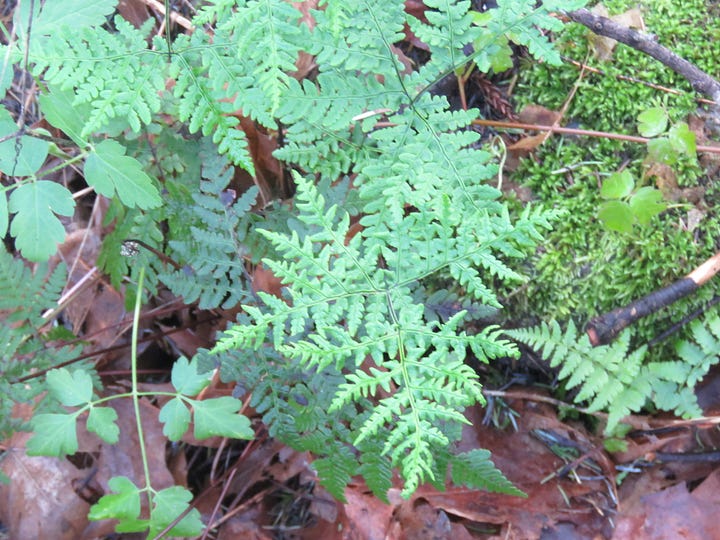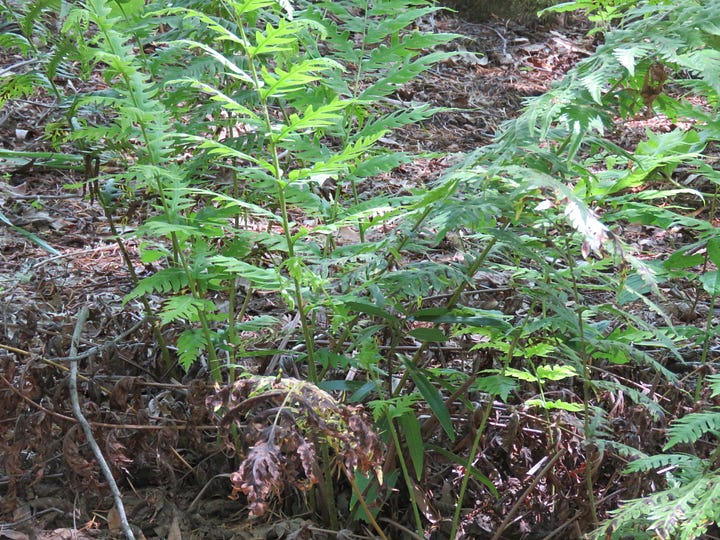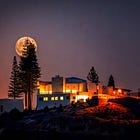Green Wednesday: The Beauty of Napa’s Ferns and the Art of Rose Care
By Kathleen Scavone, Environmental Contributor, and Bob Niklewicz & Margaret Green, U.C. Master Gardeners of Napa County
Support Napa Valley Features – Become a Paid Subscriber Today
If you’re reading this, you care about independent, locally owned, ad-free journalism — reporting that puts our region’s stories first, not corporate interests or clickbait.
As local newsrooms are increasingly bought by billionaires, scaled back or absorbed into media conglomerates, communities lose original reporting and are left with more syndicated content. Your support keeps quality regional journalism alive.
Join a community that values in-depth, independent reporting. Become a paid subscriber today — and if you already are, thank you. Help us grow by liking, commenting and sharing our work.
Green Wednesday: Gardening and Climate Insights
Every Wednesday Napa Valley Features brings you Green Wednesday, featuring articles from environmental voices and the UC Master Gardeners of Napa County. These contributors share research-based horticultural advice and insights on sustainability and climate topics relevant to our region.
Summary of Today’s Stories
"Fascinating Ferns of Napa County" by Kathleen Scavone, Environmental Contributor: This article explores the prehistoric beauty of ferns, detailing their habitats, unique reproductive cycle, and the diverse species found in Napa Valley’s woodlands and parks.
“Ferns are prehistoric plants that have been in existence since before the time of the dinosaur — around 360 million years.” — Kathleen Scavone
"How to Prepare Your Roses for a Spectacular Bloom" by Bob Niklewicz and Margaret Green, U.C. Master Gardeners of Napa County: A guide to proper rose care, explaining the importance of winter pruning, early season fertilization, and fungal prevention to ensure a spectacular bloom in the spring and summer.
“It felt like pulling off a firmly attached Band-Aid. It hurts for a moment, but it is the right thing to do.” — Bob Niklewicz and Margaret Green
Fascinating Ferns of Napa County
By Kathleen Scavone
NAPA VALLEY, Calif. — A walk in the wild offers myriad rewards with moody light breaking through treetops, the scent of fresh pine or bay to refresh your mindset, and the swaying display that ferns’ fronds supply. Ferns are prehistoric plants that have been in existence since before the time of the dinosaur — around 360 million years. Although they can survive drought conditions, they thrive in the damp setting that winter's rains have provided in Northern California and the Napa Valley. Since many other plant species have died back in the winter months, it's easier to take note of new ferns that are already popping up, with many more to come as spring draws near.




If you peruse iNaturalist you'll note a variety of specimens, photos and descriptions of ferns seen throughout the valley. With more than 35 native fern species in the Bay Area, and — according to Calscape, there are more than 100 species native to California — their “homes” vary in habitat. While some ferns are found floating in ponds, others prefer the shade that the woodlands provide, and still others thrive on dry outcrops.
For example, in Bothe-Napa Valley State Park in Calistoga there are 20 to 30 species of ferns, according to Napa Open Space District naturalist JoeJoe Clark in his short video concerning Bothe's ferns found on Youtube. Clark explains that the giant chain fern, Woodwardia fimbriata, found in the park, flourishes in moist areas and is the tallest fern in North America at up to 12 feet.
Another of Bothe's ferns, the unique licorice fern Polypodium glycyrrhiza that is seen growing on the park's Redwood Trail, was used medicinally by the valley's Indigenous people, the Wappo and Patwin who chewed on the plant's rhizomes. Ferns often go dormant in the summer months, when they lose up to 90% of their precious moisture, then return to their typical growth patterns after the winter rains.
Fern species found in Bothe's shady woodlands include the coastal wood fern, Dryopteris arguta, whose little leaves often turn away from the glaring heat of summer. This plant action bestows the plant with a unique ruffly look.
California maidenhair ferns, Adiantum jordanii, found in Bothe, were also utilized by the Indigenous people when they constructed nets and bedding from the plant's roots. Maidenhair ferns, along with ferns such as coffee fern and mosquito fern, do not appear as typical ferns do since they do not grow long fronds but instead produce small, rounded segments or lobes.
Western sword ferns, Polystichum munitum, found in Bothe and around Napa Valley, are probably the best-known native fern since they can thrive in moist or drought conditions and are one of the taller ferns, reaching around 4 feet in both height and width. These hardy plants are often used in home landscaping projects.
Goldenback or Goldback ferns, Pentagramma triangularis, found in Pope Valley and Bothe, grow along rocky slopes and cliffs. This pretty fern holds a powder under its fronds that protects it from summer's hot months.
Ferns have interesting sex lives as compared with other plant life since they reproduce via spores rather than seeds. Some even reproduce asexually. The leafy and ancient-appearing ferns will show your their remarkable spores when you look at the undersides of their feathery fronds. This is their sporophyte stage, chock-full of brown dashes or dots that are known as sporangia and hold miniscule spores. As the spores mature, the sacs come apart, allowing spores to journey along the breeze. When conditions are favorable, a spore will then germinate.
The Land Trust of Napa County stewards many lovely properties that support a variety of ferns throughout Napa County. For example, at their Archer Taylor Preserve's 399 acres on the west side of Napa Valley, where redwoods grow, their website explains, "Ferns abound in the redwoods. Sword Fern is evergreen and often grows in large clumps. California Polypody, Polypodium californicum, is a small winter-growing species with tender lance-shaped leaves or ‘fronds.’ Bracken fern, a summer plant, has fronds far larger than Polypody’s."
As rain has saturated the ground, streams have risen and moisture has encouraged Napa County's ferns, so now is a great time to take a break and find your favorite fronds. With so many species in Napa County, you're sure to find a fine feathery favorite.
Kathleen Scavone, M.A., retired educator, is a potter, freelance writer and author of “Anderson Marsh State Historic Park: A Walking History, Prehistory, Flora, and Fauna Tour of a California State Park,” "People of the Water" and “Native Americans of Lake County.” She loves hiking, travel, photography and creating her single-panel cartoon called “Rupert.”
How to Prepare Your Roses for a Spectacular Bloom
Bob Niklewicz & Margaret Green, U.C. Master Gardeners of Napa County
NAPA VALLEY, Calif. — Many of us who live in the city of Napa love the Fuller Park Rose Garden, a joint project of Master Gardeners of Napa County and the City of Napa Parks and Recreation Services Department. Master Gardener volunteers did heavy pruning in the rose garden in January for the reward of a bountiful display of blooms in May and June.
Napa is classified as U.S. Department of Agriculture Hardiness Zone 9b. We have relatively mild winters, so it’s painful to prune back roses as they would grow year-round if we let them.
We cut the Fuller Park bushes back to 18 to 30 inches, even though they were still blooming. It felt like pulling off a firmly attached Band-Aid. It hurts for a moment, but it is the right thing to do. Pruning makes the rose bush stronger, allowing the roots to store energy for the following spring.
As we enter March, the canes and stems pruned in January are now showing buds. These buds are swelling, leaves are sprouting and it looks like winter is coming to a close. However, this is not the time to sit back and wait for great things to happen. For amazing results in June, we have to work like crazy now.
According to the Napa County Master Gardeners “Rose Cycle” chart, you should conclude rose pruning by February and clean up all fallen leaves and debris. All rose debris should go into municipal compost bins to minimize problems with black spot and mildew in spring. Keeping the ground around roses clean prevents fungus from overwintering in damp debris and gives your bushes a healthy start. Soon enough you’ll be fighting off soft-body pests such as aphids.
In February we place mulch around the Fuller Park bushes to help keep moisture in the soil. We’re careful not to pack the mulch against the crown or canes as that could damage new growth.
In March, we feed them with slow-release organic fertilizer to promote spring growth. All-purpose fertilizers include varying proportions of nitrogen, phosphorus and potassium, with percentages listed on the label in that order. Nitrogen promotes green leaves and stems. Phosphorus stimulates the root system, and potassium improves disease resistance and drought tolerance.
A ratio of 10-5-5 is a good choice for early season application. If it’s well into March before you fertilize, choose a 5-10-10 formulation. Testing your soil for nitrogen, phosphorus and potassium will reveal any deficiencies and help you determine what your roses need for an impressive bloom in May and June. Just don’t overdo the recommended yearly amounts.
Early March is also a good time to check the irrigation system. It’s easier to access the water lines while the bushes are nearly bare. Fixing broken connectors and emitters now, before you need them, will prevent wasted water later. Maybe you forgot that you removed a bush and you still have emitters in that spot. Believe me, doing maintenance now, before the canes grow, will spare you puncture wounds later. Yes, I am speaking from experience. When working with roses, be sure to wear long, heavy-duty gloves.
March is also a good time to spray for fungus, if necessary. A long winter with frequent rain can stimulate fungal diseases. If you do use an anti-fungal spray, do so right after pruning, preferably on a dry, windless morning when the forecast calls for a few days of dry weather. Many sprays are easy to use, with copper, sulfur or neem oil as the active ingredient. Once roses begin to leaf out, it’s too late to spray with dormant oil (also called horticultural oil). Always remember to follow the instruction on the spray container.
Do your due diligence for your roses now, and you will be rewarded with fantastic blooms in June, if not sooner. Napa County Master Gardeners tend the Fuller Park roses twice a month, usually the first Sunday and third Thursday of the month, from 10 a.m. to noon. If you would like to talk roses with us, come on by. We’d be happy to show you what we are up to.
Events
Library Talk: Join UC Master Gardeners of Napa County for a talk on “Containing My Dahlia Enthusiasm,” on Thursday, March 6, from 7 to 8 p.m., via Zoom. Dahlias love full sun and produce dazzling flowers. However, rodents and other pests adore them as much as we do. Learn how to address these challenges and grow show-stopping blooms in pots, gopher baskets and grow bags. Click here to register.
Workshop: Join UC Master Gardeners of Napa County for a workshop on “Spring and Summer Vegetables” on Saturday, March 8, from 10 a.m. to noon at the University of California Cooperative Extension, 1710 Soscol Ave., Suite 4, Napa. Come get your hands dirty in this hands-on vegetable growing workshop. Learn what to plant now and what to plant later when the weather warms. Soil prep, irrigation, seed-starting, transplanting and potential problems: We’ll cover it all. Click here to register.
Help Desk: The Master Gardener Help Desk is available to answer your garden questions on Mondays and Fridays from 10 a.m. until 1 p.m. at the University of California Cooperative Extension Office, 1710 Soscol Ave., Suite 4, Napa. Or send your questions to mastergardeners@countyofnapa.org. Include your name, address, phone number and a brief description of the problem. For best results attach a photo.
Bob Niklewicz and Margaret Green are UC Master Gardeners of Napa County.
Today’s Polls
—
Explore These Related Articles:
Browse All Napa Valley Features Stories
—
The views, opinions and data presented in these articles are those of the authors and do not necessarily reflect the official policy, position or perspective of Napa Valley Features or its editorial team. Any content provided by our authors is their own and is not intended to malign any group, organization, company or individual.
















Bob and Margaret, great article! I plan to use it as a guide for my rose care. Thanks!